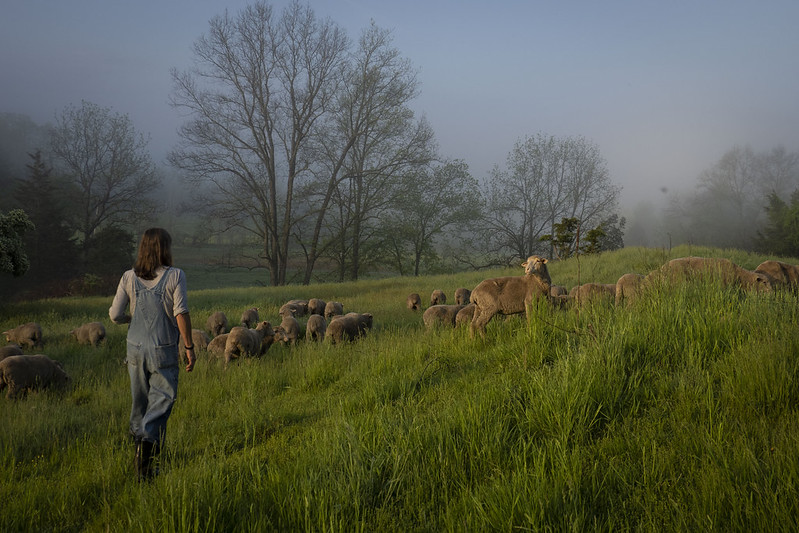Improving Pasture and Rangeland Management
The ARS pasture and rangeland management research program enhances the utility, function, and performance of rangelands, pastures, forage, and turf agroecosystems while providing ecosystem services. ARS research on smart agriculture is being conducted to enhance the resilience of agricultural systems that support resource conservation and enhance productivity. To support rural prosperity, food security, and healthy agroecosystems, ARS research helps producers improve management decisions and ultimately achieve healthy and productive pastures and rangelands, as illustrated by the following research accomplishments in 2021.
Impacts of fire on mesquite persistence. Mesquite encroachment into arid lands worldwide has negatively impacted livelihoods and ecosystems. In Texas, more than $50 million has been spent in 10 years to control mesquite. ARS researchers in Sidney, Montana, and university collaborators assessed mesquite persistence across a range of fire intensities. High-intensity fire caused mortality in 29 percent of mesquite, but did not alter soil chemistry or microbes, and did not permanently harm dominant grass species. High intensity fires are a low-cost option as part of an overall management program for reducing mesquite abundance in rangelands.
Improved pasture mixes and annual forages increase dairy cow productivity. Milk production from cows grazing pasture is the fastest growing segment of organic agriculture. One challenge of organic production is that grazing dairy cows produce up to 32 percent less milk than non-grazing cows, mostly because they eat up to 30 percent less forage. ARS researchers in Logan, Utah, and Utah State University collaborators determined how much young dairy cattle eat and grow when grazing four different grasses alone or in mixtures with the legume birdsfoot trefoil. They found the mixtures of grass and birdsfoot trefoil increased the amount dairy heifers ate by 34 percent, improved growth by 25 percent, and increased heifer value around $166. In related research, ARS scientists in University Park, Pennsylvania, and University of New Hampshire collaborators evaluated five winter annual forages for providing high-quality, lower-cost pasture in early spring to meet grazing needs that traditional pasture forages cannot. Barley showed the most potential and fewest tradeoffs for supplementing spring pastures to maximize harvest yield and livestock nutrient value. These grazing tools are now being used by dairy farmers to increase cow forage intake and milk production.
Finding cause of acute liver toxicity in cattle helps “save the ranch.” A herd of cattle in Colorado were poisoned after eating weed-contaminated alfalfa hay produced in Wyoming, resulting in the death of 165 cattle and other production losses. ARS scientists in Logan, Utah, worked with the U.S. Food and Drug Administration and Colorado State University over 5 years to identify toxic compounds in the hay and traced the poisoning back to the toxic weed Salvia reflexa in the contaminated hay. Salvia reflexa, commonly known as lanceleaf sage, is an annual native U.S. weed that is found in pastures and prairies and can be toxic to cattle, sheep, and goats. Identifying the cause of the poisoning allowed the cattle owners to file an insurance claim to recover their losses. This is the first report of Salvia causing liver injury, and the research was used to retrospectively identify the cause of poisoning in other cases. This information is now available to veterinary practitioners and diagnostic laboratories to aid in solving future cases where Salvia poisoning may be involved.
New stocking rate guide shows 72 percent more grazing capacity for semiarid rangelands. ARS developed a stocking rate guide in the 1960s for use in semiarid rangelands worldwide. The guide relates grazing animal weight gain and beef production to how much forage remains at the end of the grazing season. ARS scientists in Cheyenne, Wyoming, and Fort Collins, Colorado, and collaborators at the University of Wyoming analyzed contemporary data (2000-2018) from the same long-term study initially used for the 1960s stocking rate guide. They determined that sustainable stocking rates for western Great Plains semiarid rangelands increased by 72 percent over the past 50 years, likely due to combined effects of recovery from the 1930s Dust Bowl, more carbon dioxide in the atmosphere, and better livestock genetics. The scientists revised the guide and made it available on the web as a Colorado State University extension fact sheet. The guide is being used by more than 60 ranchers and on approximately 200,000 acres of the U.S. Forest Service Pawnee National Grassland for adaptive stocking adjustments to increase profitability, production efficiency, and resilience of the semiarid shortgrass steppe rangeland.
LOOKING AHEAD
As the U.S. Department of Agriculture's chief scientific in-house research agency, ARS focuses on solutions to agricultural problems affecting America. Each dollar invested in agricultural research results in $17 of economic impact. Going forward, ARS will continue to conduct important research with bold action, collaborative leadership, active dialogue, and a deep commitment to serving all Americans. These efforts will enable us to work together and maximize impact to achieve extraordinary results for years to come.
 Keres, Preston. Dominique Herman leads a flock of Corriedale Merino cross and Ike-de-France Merino cross to pasture for morning grazing on her farm in Warwick, New York. May 16, 2022. USDA Photo. https://flic.kr/p/2nmgCeq
Keres, Preston. Dominique Herman leads a flock of Corriedale Merino cross and Ike-de-France Merino cross to pasture for morning grazing on her farm in Warwick, New York. May 16, 2022. USDA Photo. https://flic.kr/p/2nmgCeq

